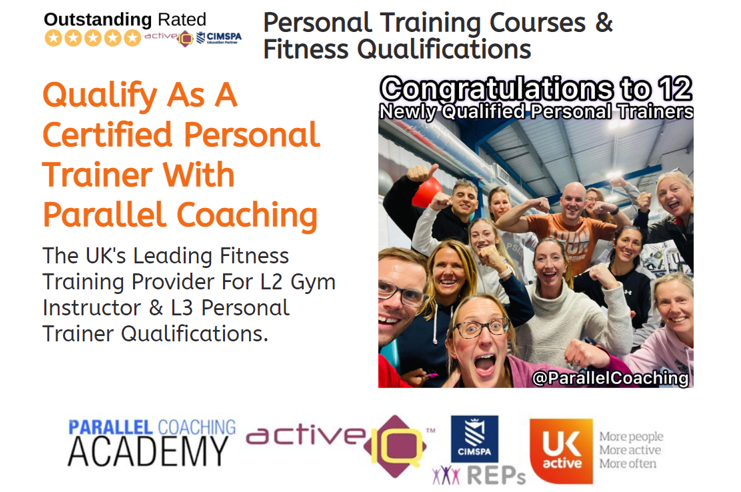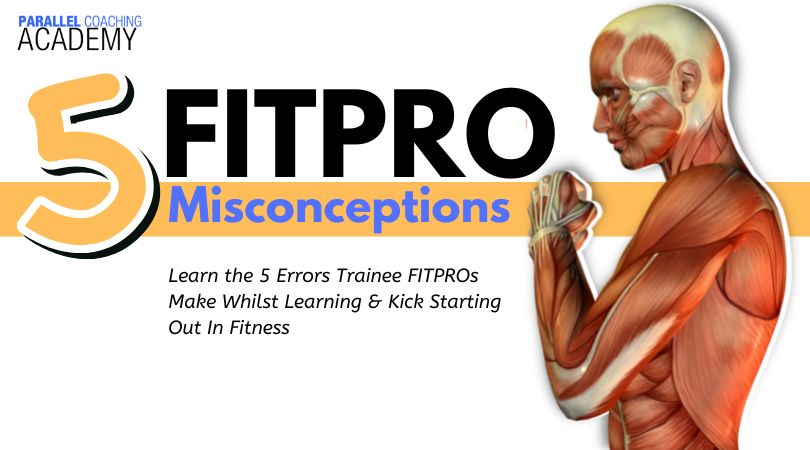There are many errors made by trainee FITPRO s when they first get started, most of these are based on misconceptions that they have. Today’s blog will explore the five top misconceptions we come across and unpick them so you don’t make the same errors.
Watch the 5 FITPRO Misconceptions:
Watch the video below, taken from our live video on our Facebook Page
1: The Muscle Memory Flashcards aren’t for Vets
It may sound strange but a surprising number of people reach out AFTER buying our Muscle Memory Flashcards and are shocked that it is based on human Anatomy and Physiology, rather than animal anatomy.
Our Muscle Memory Flashcards are for Trainee FITPRO s Struggling To Learn Muscles, which is why it explores the human muscles to help pass the level 2 (or 3) anatomy and physiology exam that Fitness Professionals need to pass in order to be qualified.
There are 37 muscles to learn at Level 2 and 50 muscles to learn at Level 3, as part of the respective anatomy and physiology exams.
The muscle memory flashcards help you learn the name, location, origin, insertion and action of all of these.
For the record, it is not about dogs, horses, fish or cats
2: Can any FITPRO teach a family Bootcamp.
The second misconception is that any FITPRO or Personal Trainer, can set up and teach a family Bootcamp, with children and adults exercising together.
However, this is not true, there are specific skill sets that are required to train both children and adults in a group setting. To help prepare your knowledge and confidence there are two qualifications that you’ll need.
The first is to make sure you are qualified to work with children, this is the Level 2 Children’s Fitness Qualification where you’ll learn how to safely plan and instruct activities for children aged 5-16 years.
The second qualification is a group fitness qualification so you understand how to manage groups and make adaptations for individuals in groups larger than 6. The clearest route to do this is via the Level 2 Circuit Training Course where you’ll learn group management, planning, and instructing and gain the confidence to kickstart your own bootcamp.
3: Every PT can work with Any Client
Next, the third misconception… is that any PT can work with any client, even if they fail a PAR-Q
However, this would be ignoring the process and intention of the PAR-Q. The idea of a PAR-Q is to provide a risk stratification so you can measure whether the client is safe to exercise.
If a client ticks YES to any PAR-Q question, or if they have a medical condition or take medications, then the client requires specialist instruction because they have a higher level of risk.
There are exercises, variables and intensities that are unsafe for a client with certain conditions to perform. It puts them at risk of a heart attack, stroke, deterioration of their condition or progression of symptoms.
That’s why it is important to be qualified to work with long-term conditions before working with clients that refer a PAR-Q. The qualification is called Level 3 Diploma in Supporting Clients With Long Term Conditions
4: That a FITPRO will never use Anatomy after their exams
Most trainee FITPRO believe that they only need to know anatomy and physiology for the fitness exams, and that after the exam it is not required.
Wrong
The reason why Anatomy and physiology knowledge is part of becoming a qualified FITPRO, is because it is a foundational knowledge that contributes to every part of being a successful FITPRO.
Anatomy is the study of parts of the human body
Physiology is the study of the function of those parts
A PT’s main role is to prescribe movement and lifestyle advice to help a client make changes in their body. It is important for a PT to understand the parts of the body and how they all work together.
This is much like how a mechanic needs to know about all car parts and how they work together.
When taking your car to a mechanic to get fixed, you’d expect the mechanic to have a good understanding of car parts and how they work together. You expect the mechanic to be able to find a solution based on this knowledge.
The same applies to you as a Personal Trainer, before prescribing a series of exercises, variables, intensities and training programmes, you need to know how the body works and all the parts of the body.
Results Come From Anatomical and Physiological Adaptation
When a client approaches you as a Personal Trainer, they are asking you to help them achieve a goal. Goals include:
- Weight loss/ Fat loss
- Muscle gain
- Endurance
- Improved fitness / Vo2 Max
- Faster speed
- Increased strength
- and many more
The achievement of the goal is reliant on making anatomical and physiological adaptations. Without understanding these adaptations, a Personal Trainer can only rely on tactics, and cannot guarantee the achievement of their goal.
Having an understanding of anatomy and physiology means you can pick the right training variables, cv/rt biases, intensities, durations and training systems.
For example, you know a speed goal, requires activation of the Creatine Phosphate energy system, which is an intense cardiovascular exercise for short durations (up to 10 secs) and matched with low rep ranges in resistance training. Keep reading more HERE
5: Real Learning Comes Once You’re Qualified
A common misconception is that a trainee FITPRO will learn most of their skills whilst on the job and working with clients. This may be true to the point that working with real clients brings a level of experience that is incomparable to that which can be taught in a classroom. You’ll learn loads of interpersonal, communication and organisational skills that the PT syllabus just doesn’t cover.
However, the danger of this misconception is that you pick a low standard course, that leaves you under confident and lacking the systems and processes to apply to a real client.
This means that you run the risk of not feeling confident to ever kick-start asa FITPRo, you never get your first few clients, you never practice and you never learn that extra knowledge from working with a real client.
It is a vicious cycle of lack of confidence that leaves you further from working with a client
Instead set yourself up for success and enrol on a PT course that give you all the resources to prepare you for the fitness industry, give you chance to practice on other people, and teach you how to apply your knowledge to get real client results..
Thats why we include the things that we believe are non-begotiable for a PT to know, so they can feel confident when working with a client straight away.
- 10 days face-to-face attendance so you can practice instructing and build confidence
- Fitness Business Kick-Starter, so you know how to get your first few clients
- Kettlebells CPD course so you adapt to at-home or outside PT sessions easily
- Squat Assessment Bootcamp so you know how to analyse a client effectively
- Training Clients Outside so you can build a business outside of a gym with no equipment
- FIT-Progressions Advanced Training Systems CPD so you can refresh knowledge for a lifetime
- Level 2 & Level 3 Anatomy & Physiology Revision Bootcamps to learn and pass the exams confidently and use the knowledge as a FITPRO
- Level 3 Nutrition Revision Bootcamp so you can pass the exam and help every client with calorie and portion guidance
- Level 2 & 3 Muscle Memory Sprints to learn all the muscles with ease
- Next step Career Consultation so you have someone to ask and guide you about your role as a FITPRO
- 24/7 Student Support so you have someone on hand whenever you are stuck
Get started in your FITPRO career without any misconceptions or hindering beliefs. Find out more about our Level 3 Master Personal Trainer Diploma HERE <<<
Qualify as a Personal Trainer
This is the fitness industry’s GOLD standard qualification to kick start a career in health and fitness & start training clients 121 and in small groups.

Personal trainers use their expertise on a daily basis to get inside the heads of their clients, design training programs that deliver results, and support life-improving health, fitness, and nutrition changes to their client’s lives.
Personal training is a results business and quite often, the results people achieve can be remarkable. If you feel that you have what it takes to help people to take control of their health, fitness, and wellbeing, then maybe it’s time for you to step up and join the ranks?
>>>> Join us on the Master Personal Trainer Course HERE
Test your knowledge with today’s mock questions:
[NOTE: The answers are below the 3rd question]
Q1: How many muscles need to be learned as part of the level 3 Anatomy and Physiology exam?
A. 90
B. 50
C. 37
D. 40
Q2: Which qualification is needed to work with a 13 year old client as a PT?
A. A level 3 personal training qualification
B. A level 2 gym instructor qualification
C. A qualified school teacher
D. A level 2 certificate in children’s fitness
Q3: What is a benefit of understanding of anatomy and physiology beyond your exam?
A. You can pick the right training variables, cv/rt biases, intensities, durations and training systems, relevant to achieving a set goal.
B. You can chose randow variables to create a plan for the client, irrespective of the goal.
C. You can use google search to find a plan for a client.
D. You can list exercises and muscles worked
Answers to the mock questions are :
Question 1= B, Question 2 = D, Question 3 = A
If you want more mock questions like this, then you can download more Free Mock Questions: DOWNLOAD NOW
Dedicated to More
Hayley “5 FITPRO Misconceptions” Bergman
Parallel Coaching
P.S. You can also find us on the following platforms:
Instagram: https://www.instagram.com/parallelcoaching
Facebook: https://www.facebook.com/ParallelCoaching
Twitter: https://twitter.com/ParallelCoach
YouTube: http://bit.ly/2F1Z1bs
Read more FITPRO blogs: HERE

